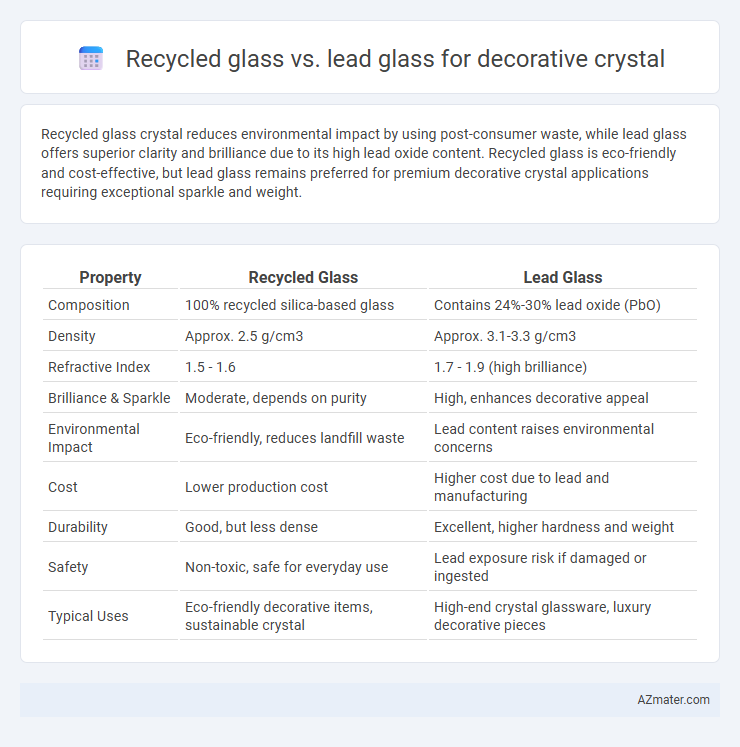Recycled glass crystal reduces environmental impact by using post-consumer waste, while lead glass offers superior clarity and brilliance due to its high lead oxide content. Recycled glass is eco-friendly and cost-effective, but lead glass remains preferred for premium decorative crystal applications requiring exceptional sparkle and weight.
Table of Comparison
| Property | Recycled Glass | Lead Glass |
|---|---|---|
| Composition | 100% recycled silica-based glass | Contains 24%-30% lead oxide (PbO) |
| Density | Approx. 2.5 g/cm3 | Approx. 3.1-3.3 g/cm3 |
| Refractive Index | 1.5 - 1.6 | 1.7 - 1.9 (high brilliance) |
| Brilliance & Sparkle | Moderate, depends on purity | High, enhances decorative appeal |
| Environmental Impact | Eco-friendly, reduces landfill waste | Lead content raises environmental concerns |
| Cost | Lower production cost | Higher cost due to lead and manufacturing |
| Durability | Good, but less dense | Excellent, higher hardness and weight |
| Safety | Non-toxic, safe for everyday use | Lead exposure risk if damaged or ingested |
| Typical Uses | Eco-friendly decorative items, sustainable crystal | High-end crystal glassware, luxury decorative pieces |
Introduction to Decorative Crystal Materials
Decorative crystal materials often utilize recycled glass and lead glass, each offering unique properties for enhancing clarity and brilliance. Recycled glass promotes sustainability by reducing environmental impact while maintaining good optical quality, making it suitable for eco-conscious decorative pieces. Lead glass, containing 24-30% lead oxide, delivers superior brilliance and a high refractive index, prized for traditional luxury crystal items due to its weight and sparkle.
Overview of Recycled Glass
Recycled glass for decorative crystal is crafted by melting down post-consumer or industrial glass waste, reducing environmental impact through lower energy consumption and raw material use compared to lead glass production. It maintains high clarity and durability, making it a sustainable alternative with a smaller carbon footprint while avoiding the toxicity associated with lead content. The use of recycled glass supports circular economy principles, offering aesthetically appealing crystal products without compromising on quality or safety.
What is Lead Glass?
Lead glass, also known as lead crystal, contains a significant percentage of lead oxide, typically between 18% and 30%, which enhances its brilliance, weight, and clarity compared to regular glass. This lead content lowers the melting point and increases refractive index, making lead glass highly prized for decorative crystal items like vases, chandeliers, and fine glassware. Recycled glass, while environmentally friendly, generally lacks the high lead content and optical properties that give lead glass its distinctive sparkling appearance and tactile weight.
Aesthetic Differences: Recycled vs Lead Glass
Recycled glass in decorative crystal often exhibits a subtle, muted clarity with tiny inclusions or air bubbles that add a unique, artisanal character, contrasting sharply with the pristine, high refractive index and brilliant sparkle typical of lead glass. Lead glass is renowned for its exceptional brilliance and light dispersion, which create vivid, rainbow-like prismatic effects that recycled glass rarely achieves due to lower density and lead absence. The aesthetic choice between recycled and lead glass balances eco-conscious texture and uniqueness versus traditional clarity and dazzling brilliance, influencing decorative crystal's visual impact and luxury appeal.
Environmental Impact Comparison
Recycled glass reduces raw material extraction and lowers energy consumption by up to 30%, significantly decreasing carbon emissions compared to lead glass production, which involves toxic lead oxide that poses environmental and health hazards. Lead glass manufacturing contributes to heavy metal pollution and requires specialized disposal methods to prevent soil and water contamination. Choosing recycled glass for decorative crystal supports circular economy principles and mitigates environmental risks associated with lead toxicity.
Safety Concerns: Lead Content and Health
Recycled glass decorative crystal typically contains no lead, significantly reducing health risks such as lead poisoning and prolonged toxicity exposure faced with traditional lead glass. Lead glass, or crystal, composed of up to 30% lead oxide, poses safety concerns due to potential lead leaching during prolonged contact with liquids or physical wear. Choosing recycled glass offers a safer alternative for households looking to avoid the hazardous effects of lead on the nervous system and overall health.
Durability and Maintenance
Recycled glass in decorative crystal offers comparable durability to lead glass, with enhanced resistance to scratches and environmental wear due to its modern manufacturing processes. Lead glass, traditionally prized for its brilliance and weight, requires careful maintenance to prevent tarnishing and surface damage from acidic or abrasive substances. Both materials benefit from gentle cleaning with non-abrasive solutions, but recycled glass tends to sustain its appearance longer with less frequent polishing or special care.
Cost Analysis: Recycled Glass vs Lead Glass
Recycled glass for decorative crystal offers a significant cost advantage over lead glass due to lower raw material expenses and reduced energy consumption during production. Lead glass involves higher costs associated with lead oxide, specialized manufacturing processes, and environmental compliance measures. Overall, recycled glass presents an economically viable alternative, balancing sustainability with affordability in decorative crystal applications.
Market Trends in Decorative Crystal
The market for decorative crystal is increasingly favoring recycled glass due to growing environmental awareness and sustainable production practices, with recycled glass offering a lower carbon footprint compared to traditional lead glass. Despite lead glass maintaining a niche market for its superior clarity and weight, regulatory restrictions on lead usage are accelerating the shift towards eco-friendly alternatives. Innovations in recycled glass technology are enhancing optical quality, enabling it to compete effectively with lead glass in high-end decorative crystal applications.
Choosing the Right Material for Decorative Crystal
Recycled glass offers an eco-friendly choice for decorative crystal, featuring reduced environmental impact and distinctive textures ideal for sustainable design projects. Lead glass, known for its high refractive index and clarity, remains preferred for premium decorative crystal applications due to its brilliance and weight. Selecting between recycled and lead glass depends on balancing environmental considerations with desired optical qualities and budget constraints.

Infographic: Recycled glass vs Lead glass for Decorative crystal
 azmater.com
azmater.com